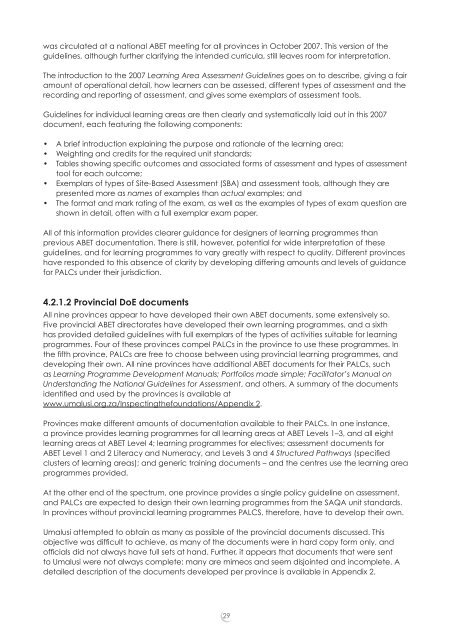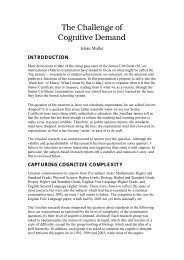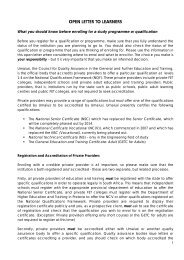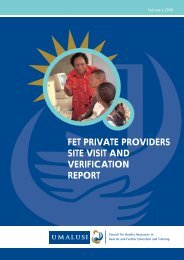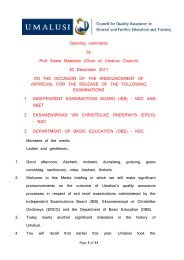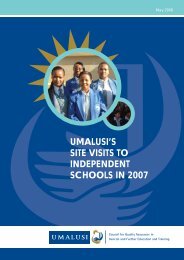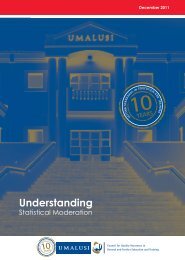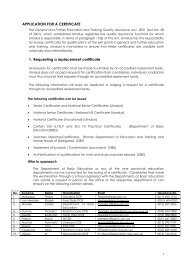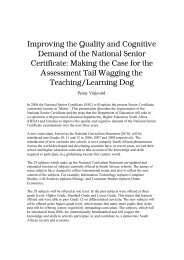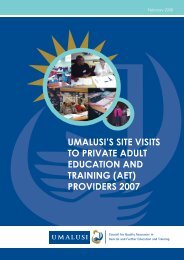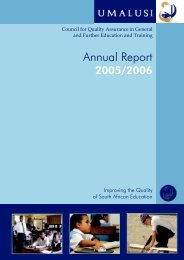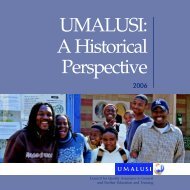was circulated at a national ABET meeting for all provinces in October 2007. This version of <strong>the</strong>guidelines, although fur<strong>the</strong>r clarifying <strong>the</strong> intended curricula, still leaves room for interpretation.The introduction to <strong>the</strong> 2007 Learning Area Assessment Guidelines goes on to describe, giving a fairamount of operational detail, how learners can be assessed, different types of assessment and <strong>the</strong>recording and reporting of assessment, and gives some exemplars of assessment tools.Guidelines for individual learning areas are <strong>the</strong>n clearly and systematically laid out in this 2007document, each featuring <strong>the</strong> following components:• A brief introduction explaining <strong>the</strong> purpose and rationale of <strong>the</strong> learning area;• Weighting and credits for <strong>the</strong> required unit standards;• Tables showing specifi c outcomes and associated forms of assessment and types of assessmenttool for each outcome;• Exemplars of types of Site-Based Assessment (SBA) and assessment tools, although <strong>the</strong>y arepresented more as names of examples than actual examples; and• The format and mark rating of <strong>the</strong> exam, as well as <strong>the</strong> examples of types of exam question areshown in detail, often with a full exemplar exam paper.All of this information provides clearer guidance for designers of learning programmes thanprevious ABET documentation. There is still, however, potential for wide interpretation of <strong>the</strong>seguidelines, and for learning programmes to vary greatly with respect to quality. Different provinceshave responded to this absence of clarity by developing differing amounts and levels of guidancefor PALCs under <strong>the</strong>ir jurisdiction.4.2.1.2 Provincial DoE documentsAll nine provinces appear to have developed <strong>the</strong>ir own ABET documents, some extensively so.Five provincial ABET directorates have developed <strong>the</strong>ir own learning programmes, and a sixthhas provided detailed guidelines with full exemplars of <strong>the</strong> types of activities suitable for learningprogrammes. Four of <strong>the</strong>se provinces compel PALCs in <strong>the</strong> province to use <strong>the</strong>se programmes. In<strong>the</strong> fi fth province, PALCs are free to choose between using provincial learning programmes, anddeveloping <strong>the</strong>ir own. All nine provinces have additional ABET documents for <strong>the</strong>ir PALCs, suchas Learning Programme Development Manuals; Portfolios made simple; Facilitator’s Manual onUnderstanding <strong>the</strong> National Guidelines for Assessment, and o<strong>the</strong>rs. A summary of <strong>the</strong> documentsidentifi ed and used by <strong>the</strong> provinces is available atwww.umalusi.org.za/<strong>Inspecting</strong><strong>the</strong>foundations/Appendix 2.Provinces make different amounts of documentation available to <strong>the</strong>ir PALCs. In one instance,a province provides learning programmes for all learning areas at ABET Levels 1–3, and all eightlearning areas at ABET Level 4; learning programmes for electives; assessment documents forABET Level 1 and 2 Literacy and Numeracy, and Levels 3 and 4 Structured Pathways (specifi edclusters of learning areas); and generic training documents – and <strong>the</strong> centres use <strong>the</strong> learning areaprogrammes provided.At <strong>the</strong> o<strong>the</strong>r end of <strong>the</strong> spectrum, one province provides a single policy guideline on assessment,and PALCs are expected to design <strong>the</strong>ir own learning programmes from <strong>the</strong> SAQA unit standards.In provinces without provincial learning programmes PALCS, <strong>the</strong>refore, have to develop <strong>the</strong>ir own.<strong>Umalusi</strong> attempted to obtain as many as possible of <strong>the</strong> provincial documents discussed. Thisobjective was diffi cult to achieve, as many of <strong>the</strong> documents were in hard copy form only, andoffi cials did not always have full sets at hand. Fur<strong>the</strong>r, it appears that documents that were sentto <strong>Umalusi</strong> were not always complete: many are mimeos and seem disjointed and incomplete. Adetailed description of <strong>the</strong> documents developed per province is available in Appendix 2.29
4.2.1.3 IEB documentsThe IEB has User Guides (2006) for Communication in English (ABET Levels 1–2; 3, and 4), and forNumeracy (for ABET Levels 1–2) and Ma<strong>the</strong>matical Literacy (ABET Levels 3 and 4), which arecirculated to all its registered providers. These user-guides are intended to serve as guidelines in<strong>the</strong> development of curriculum material. All eight user-guides follow <strong>the</strong> same format which isdescribed briefl y in this section. User guides are provided in all <strong>the</strong> eight learning areas <strong>the</strong> IEBassesses: Communication in English, and Ma<strong>the</strong>matical Literacy, Economic and ManagementScience (2007), Life Orientation (2008), Human and Social sciences (2008), Natural Sciences (2009),SMME (2008) and Technology (2009).The 120–150 page user-guides are bound books with fi ve sections each. While not actual learningprogrammes, <strong>the</strong>se books provide detailed and clear curriculum guidelines for all aspects of<strong>the</strong> curriculum apart from content. For example, <strong>the</strong> fi rst section contains necessary generalinformation about <strong>the</strong> IEB, <strong>the</strong> NQF, outcomes, unit standards, assessment, and moderation.The next three sections cover assessment and examination requirements in detail, includingexamination and internal assessment exemplars toge<strong>the</strong>r with memoranda and commentarywith specifi c tips on how to assess in that particular learning area at that level. Exemplar questionpapers are given with explanatory comments on all questions in <strong>the</strong> exam paper, and fi ve markedexemplar learners’ answer papers are also included. There are fur<strong>the</strong>r sample tasks for typicalexam tasks, with marking memoranda. Formative and summative SBA is explained with examplesand marking memoranda, and elaborated assessment tools are provided. The last sections ofeach book consist of summaries of learning outcomes and assessment criteria in an easy-to-readformat. Curriculum requirements are phrased clearly in terms of <strong>the</strong> core competencies within <strong>the</strong>unit standards – not as unit standards, and <strong>the</strong>re are no unit standard numbers and formats. Eachcore competency and outcome is described in narrative text, and information on how to integrateand scaffold outcomes is provided. Examples in <strong>the</strong> books are suffi ciently explicit to go some waytowards providing models for learning programmes.4.2.1.4 PALC documentsThe multiplicity of national and provincial curriculum documents is mirrored by <strong>the</strong> existence ofa variety of local documents, which were developed by <strong>the</strong> PALCs. These local documents arevariable in quality. <strong>Umalusi</strong> attempted to access a sample of <strong>the</strong> GETC: ABET documents andmaterials developed by <strong>the</strong> PALCs: four provincial ABET directorates provided lists of PALCS for<strong>the</strong>ir provinces, which facilitated contacting a selection of <strong>the</strong>se centres and obtaining localdocuments. Of <strong>the</strong> four sets of responses from centres, information in three roughly matched thatgiven by <strong>the</strong> corresponding provincial offi cials (summaries of responses from PALCs to <strong>Umalusi</strong>interview questions are available at www.umalusi.org.za/<strong>Inspecting</strong><strong>the</strong>foundations/Appendix3).In provinces where PALCs are provided with provincial learning programmes, <strong>the</strong>se are beingused by most of <strong>the</strong> centres contacted. In <strong>the</strong> province which has no offi cial provincial learningprogrammes, many centres are never<strong>the</strong>less using whatever <strong>the</strong> department provided as learningprogrammes.Three individual PALCs responded to <strong>Umalusi</strong>’s attempts to obtain learning programmes developedat <strong>the</strong> level of <strong>the</strong> centre. One, in <strong>the</strong> Eastern Cape, sent an example of an integrated learningprogramme. This document is a single page. It gives <strong>the</strong> <strong>the</strong>me of <strong>the</strong> programme and links, byusing a table, specifi c outcomes, content, instructional strategies, learner activities, assessmentcriteria and strategies, and resources needed. A second PALC, in Gauteng, sent eight learningprogrammes. These are between two and six pages long, and also in tabular form. They link unitstandard titles, specifi c outcomes, credits, and national (sic) hours. There are columns for activitiesand dates, but <strong>the</strong>se are blank. None of <strong>the</strong>se PALC learning programmes provide enoughinformation to facilitate evaluation of <strong>the</strong> quality of <strong>the</strong> programmes. A third PALC, in <strong>the</strong> WesternCape, appears to be offering learning programmes that are not part of larger qualifi cations, butwhich are never<strong>the</strong>less apparently accredited. These programmes are dealt with in <strong>the</strong> section onenrichment courses below.30


